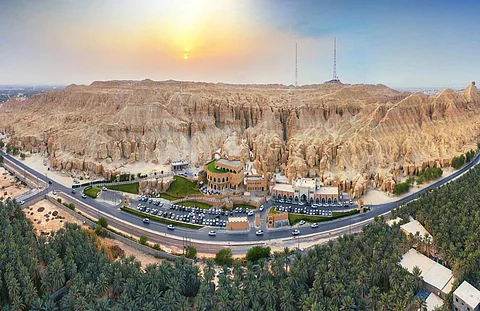

Al-Ahsa Oasis, strategically located in the eastern Arabian Peninsula between Riyadh and Dammam, was inscribed on the World Heritage List in 2018. Al-Ahsa is globally known for being the largest date-palm oasis not only on UNESCO's list, but also in the whole world with about 3 million palm trees spreading across 30,000 acres and it is also known for producing the finest date in the world; Al-Khalasah or as locally named as Al-Khlas with a daily production amounts to five tons.
Al-Ahsa features wide gardens, canals,water springs, wells, landscapes, vast green spaces, anda drainage lake. Al-Ahsa gained a world fame for combining historicalbuildings, urban fabric, and archaeological sites, such as the remaining ofhistoric fortresses, mosques, wells, canals and different rudimentary systemsfor water management, which collectively represent a witness to the humanexistence in the Gulf region in general and the Arabian Peninsula in particularsince the Neolithic period. The tranquil oasis, which has a historicalsignificance is considered one of the most perfect destinations for recreationand cultural tourism.
Jawatha mosque—it is one of the earliest mosques in Islam that was built in 7 AH- 628 AD in Al-Ahsa. It is noteworthy that Jawatha mosques is the second mosque to hold Friday congregation prayer in Islam other than the Prophet's Mosque. It was re-built by The Saudi General Commission for Tourism and National Heritage.
Jabl Qarah (Mountain of Al-Qarah)—no one can visit Al-Ahsa without passing by Jabl Qarah. It is one of the most appealing natural attractions for photographers due to the fascinating caves it has. These caves are the secret behind this mountain fame; it is formed of sedimentary rocks with a distinctive red color, it has been a cool haven for the inhabitants away from the summer heat as well as being a warm haven for them in the winter, and it overlooks palm trees and orchards.
Suq Al-Qaysariyah—a historic market that is still able to compete the contemporary markets in Al-Ahsa. It is considered the oldest market in the Arabian Gulf dating back six centuries with a prominent social and economic importance. It is an age-old forum for traditional handicrafts such as textiles, Saudi cloaks, swords, daggers, wood and leather souvenirs, pottery pieces, hand-made garments made of camel hair or wool, apart from the dates, herbs, and folk medicines. The market's buildings are of an architectural style that combines the originality and the diversity.
Al-Uqair Port—the first marine port in Saudi Arabia and the oldest one in the Arabian Gulf dates back 1,500 years, yet it lastly received a ship since more than half a century. It has witnessed the consecutive civilizations in Al-Ahsa. It was the hub that King Abdul-Aziz used to meet the British delegates and negotiate with the British Government.
Springs and fresh water sources—As mentioned here, Al-Ahsa has millions of palm trees that are irrigated by more than sixty artesian springs providing hot and cold water. The excess water directs to Al-Asfar Lake (Yellow Lake) and Al-Uyoun Lake. Al-Asfar Lake is considered the largest water body in the region with an integrated wildlife. It features a dark color in the Summer due to the increase of the agricultural drainage and a lighter dark in the Winter due to rain water.
Al-Shu'ba Mountain—it is where one can enjoy a special morning with his family with a matchless view overlooking the surrounding palm trees. Being an amateur of drifting, Al-Shu'ba mountain is a perfect destination for you.
Masjid Qubba—it is the first mosque in Islam that was built in 1569 AD with mud bricks on a raised brick platform inside the courtyard of the castle. It is characterized by four minarets, 56 domes, a residential annex for prayer leaders and announcers, adding to an important library.
Al-Ahsa Palaces—there are three remaining palaces in Al-Ahsa; Sahood Palace that was built during the Ottoman rule with a cannon inside it to protect the city from the Bedouins, Khuzam Palace that was built in 1932 taking a typical rectangular shape surrounded by a deep trench, and Al-Fakhriya Palace that was built at the turn of the twentieth century with an authentic local architectural style.
Princes' School—it was opened in 1941 to be one of the first schools in the Arabian Gulf attended by the urban elite and members of the Royal family. Lately, the Heritage Foundation renovated and turned it into a museum showing the traditional teaching methods.
Al-Battaliyah-Al-Hassan mosque—it was built in the tenth century under the Ottomanrule with an Islamic design with seven corridors on each side of thecentral door opening onto a large square courtyard surrounded by a wall. It is not considered only one of the oldest mosques inAl-Ahsa Oasis but one of the most important historical buildings as well.
